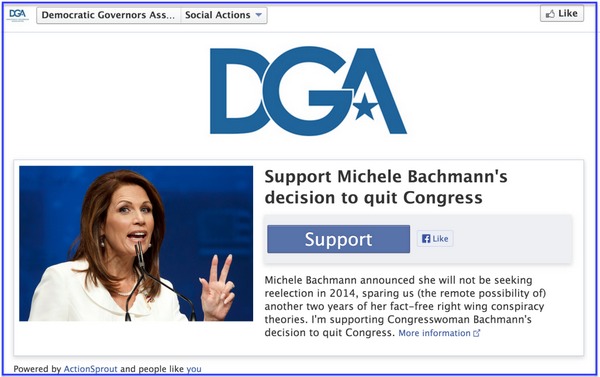
Run more efficient list-building campaigns through the use of social media & third-party tools
Target audience: Nonprofits, cause organizations, foundations, NGOs, social enterprises, businesses, educators, Web publishers, Facebook administrators.
 Any organization serious about growing its email list eventually asks: “What’s a more effective place to acquire emails, Facebook or my website?”
Any organization serious about growing its email list eventually asks: “What’s a more effective place to acquire emails, Facebook or my website?”
Unfortunately, there’s no quick answer for this one. But there is an awesome case study from Jon Stahl, director of strategy for ActionSprout, a startup that has built a suite of tools to spur engagement on Facebook. And the results may spur you to try ActionSprout, or a similar service, for your next campaign. (We wrote about ActionSprout late last year.)
First, a quick overview. The Democratic Governors Association has a Facebook page with about 232,000 fans. In May and June, DGA ran 11 campaigns on Facebook, each of which they promoted with one to three Facebook page posts.
Here are some of their results with ActionSprout:
- DGA’s posts were seen about 2 million times. 1.6 million were paid impressions using Promoted Posts and 400,000 were organic impressions.
- DGA engaged more than 58,000 people, with 9,377 of those people taking actions — in turn, providing DGA with their name and email.
- To state the previous point more simply, DGA acquired 9,377 names and emails. And 5,250 of these were people new to the organization.
- DGA acquired 58,000 names and Facebook IDs that they can use for targeting Facebook ads.
- More than 5,800 people engaged with three or more ActionSprout posts.
- 9.2% of the 9,377 action takers were responsible for 21.2% of the total actions taken. ActionSprout allows DGA to tag these people for future campaigns.
- Nearly 43% of all campaign views came from mobile devices, underscoring the importance of making sure your emails and landing pages are mobile friendly.
- DGA spent about $16,000 on Facebook promoted post advertising with ActionSprout links and had an average cost per acquisition of $1.53.
Mark Giangreco, director of digital communications for DGA, said, “We are using ActionSprout to run more effective, more efficient list-building campaigns that fully leverage the power of social media. It’s challenging us to rethink the way we advertise on Facebook.”
ActionSprout vs. traditional offsite landing page
DGA ran a number of tests comparing an ActionSprout-powered campaign with a traditional website landing page to sign a petition. Both campaigns also included a post-action donation ask.
Facebook post A/B testing
DGA created two posts designed push back against Texas Gov. Rick Perry’s attack on women’s health. The posts were identical in all respects except one post contained a link to an ActionSprout campaign and the other contained a link to a traditional landing page. They targeted the ActionSprout posts to 55 year olds and the landing page posts to 56 year olds (Facebook doesn’t allow true randomized A/B testing, but this is an effective alternative).
ActionSprout results
The ActionSprout campaign generated 402 actions at $1.11 per acquisition. The offsite landing page generated 290 actions at $1.61 per acquisition. While the conversion rates of the posts were nearly identical, the viral boost from the ActionSprout posts drove actions that were 31% more cost effective than the offsite petition.
Make sense? Any questions about this? Start experimenting with similar approaches for your nonprofit or social good campaign.
Related on Socialbrite
• ActionSprout: Engage supporters beyond like, share & comment
• Growing nonprofits and social movements with NationBuilder
• How Salsa Labs enables positive social action
• Crowdshout: Social advocacy made simple
• Tools for e-advocacy: Resources for cause campaigns
• Resources for social advocates
• 10 top tools for cause campaignsJohn Haydon delivers social web strategy solutions for “the quick, the smart, and the slightly manic.” Curious? Then visit the John Haydon blog, follow him on Twitter or leave a comment.
 This work is licensed under a Creative Commons Attribution-NonCommercial 3.0 Unported.
This work is licensed under a Creative Commons Attribution-NonCommercial 3.0 Unported.








